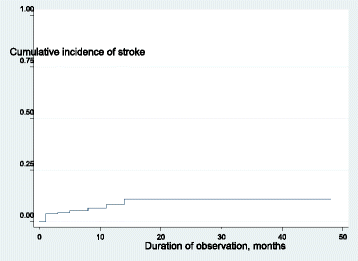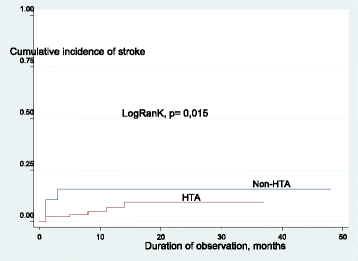Reverse epidemiology of elevated blood pressure among chronic hemodialysis black patients with stroke: a historical cohort study
- PMID: 28854899
- PMCID: PMC5577846
- DOI: 10.1186/s12882-017-0697-0
Reverse epidemiology of elevated blood pressure among chronic hemodialysis black patients with stroke: a historical cohort study
Abstract
Background: Stroke is the third leading cause of cardiovascular mortality in dialysis patients. The objective of this study was to assess the extent of stroke in chronic hemodialysis patients.
Methods: Historical cohort of patients enrolled in two hemodialysis (HD) centers from January 1, 2010 to December 31, 2011, including 191 patients (mean age 52 years, 68% men). Incidence curves and survival time analysis between the first day of HD and the end of the study were described by the Kaplan-Meier method. Independent stroke predictors were identified by multiple logistic regression analysis. P < 0.05 defined the level of statistical significance.
Results: 12 incident stroke were recorded during the study period, with 1622.1 person-months (PM), a stroke incidence rate of 7.4 cases per 1000 PM (95% CI = 7.35-7.44) at the point date. The incidence of stroke at 6 months, 12 months and 24 months was 9.8%, 11.9% and 13%, respectively. Only the absence of arterial hypertension (RR = 5.7, 95% CI: 1.52-21.42) emerged as an independent determinant of stroke.
Conclusion: The high incidence of stroke in Kinshasa HD centers is partially explained by reverse epidemiology. Efforts must be made to understand this phenomenon in order to reduce its impact.
Keywords: Black people; Hemodialysis; Incidence; Reverse epidemiology; Stroke.
Conflict of interest statement
Competing interest
The authors declare that they do not have any financial interest with the information contained in this paper.
Ethics approval and consent to participate
The study protocol was approved by the Clinical Research Ethics Committee of Public Health’s School (Kinshasa, DRC), number ESP/CE/019/2016. This is a retrospective study and written informed consent was not required.
Consent for publication
Not applicable.
Publisher’s Note
Springer Nature remains neutral with regard to jurisdictional claims in published maps and institutional affiliations.
Figures
Similar articles
-
Factors associated with residual urine volume preservation in patients undergoing hemodialysis for end-stage kidney disease in Kinshasa.BMC Nephrol. 2018 Mar 20;19(1):68. doi: 10.1186/s12882-018-0865-x. BMC Nephrol. 2018. PMID: 29554877 Free PMC article.
-
Appraising stroke risk in maintenance hemodialysis patients: a large single-center cohort study.Am J Kidney Dis. 2012 Feb;59(2):249-57. doi: 10.1053/j.ajkd.2011.07.016. Epub 2011 Sep 23. Am J Kidney Dis. 2012. PMID: 21944665
-
[REIN Report 2011--summary].Nephrol Ther. 2013 Sep;9 Suppl 1:S3-6. doi: 10.1016/S1769-7255(13)70036-1. Nephrol Ther. 2013. PMID: 24119584 French.
-
Effect of hypertension before beginning dialysis on survival of hemodialysis patients.Am J Kidney Dis. 2003 Apr;41(4):814-21. doi: 10.1016/s0272-6386(03)00029-5. Am J Kidney Dis. 2003. PMID: 12666068 Review.
-
Intensive Hemodialysis, Blood Pressure, and Antihypertensive Medication Use.Am J Kidney Dis. 2016 Nov;68(5S1):S15-S23. doi: 10.1053/j.ajkd.2016.05.026. Am J Kidney Dis. 2016. PMID: 27772639 Review.
Cited by
-
Prognostic Significance of Abnormal Ankle-Brachial Index Among Long-term Hemodialysis Patients in Kinshasa, the Democratic Republic of the Congo.Rambam Maimonides Med J. 2021 Jan 19;12(1):e0001. doi: 10.5041/RMMJ.10427. Rambam Maimonides Med J. 2021. PMID: 33478626 Free PMC article.
-
Clinical Course and Outcome of ESRD Patients on Maintenance Hemodialysis Infected with COVID-19: A Single-Center Study.Int J Nephrol Renovasc Dis. 2021 Jun 30;14:193-199. doi: 10.2147/IJNRD.S310035. eCollection 2021. Int J Nephrol Renovasc Dis. 2021. PMID: 34234514 Free PMC article.
-
G1 is the major APOL1 risk allele for hypertension-attributed nephropathy in Central Africa.Clin Kidney J. 2018 Oct 9;12(2):188-195. doi: 10.1093/ckj/sfy073. eCollection 2019 Apr. Clin Kidney J. 2018. PMID: 30976395 Free PMC article.
-
Vascular Access Type and Survival Outcomes in Hemodialysis Patients: A Seven-Year Cohort Study.Medicina (Kaunas). 2025 Mar 25;61(4):584. doi: 10.3390/medicina61040584. Medicina (Kaunas). 2025. PMID: 40282874 Free PMC article.
-
Bioinformatics analysis of comorbid mechanisms between ischemic stroke and end stage renal disease.Sci Rep. 2025 May 16;15(1):17060. doi: 10.1038/s41598-025-01049-4. Sci Rep. 2025. PMID: 40379713 Free PMC article.
References
-
- Sozio S, Amstrong P, Coresh J, Jaar B, Fink N, Plantinga L, et al. Cerebrovascular disease incidence, characteristics, and outcomes in patients initiating dialysis: the choices for healthy outcomes in caring for ESRD (CHOICE)study. AJKD. 2009;54:468–477. doi: 10.1053/j.ajkd.2009.01.261. - DOI - PMC - PubMed
MeSH terms
LinkOut - more resources
Full Text Sources
Other Literature Sources
Medical



